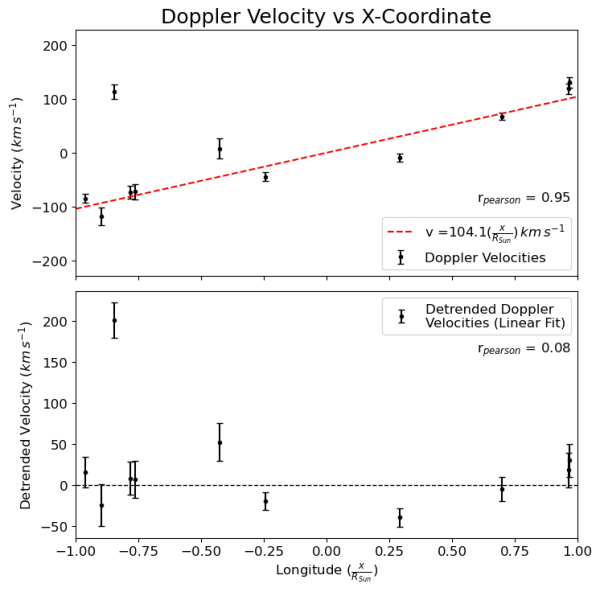SOLSTICE observes flare Doppler shifts in Si III
| Nugget | |
|---|---|
| Number: | 505 |
| 1st Author: | Luke MAJURY |
| 2nd Author: | |
| Published: | September 30, 2025 |
| Next Nugget: | TBD |
| Previous Nugget: | Flare Phases and the Earth's Ionospheric Response |
Introduction
EUV spectroscopy can infer mass motions in the solar atmosphere, which are driven by the rapid injection of energy during solar flares, through measurement of spectral line Doppler shifts. These directly characterize the line-of-sight flow speed in the medium containing the emitting ion species. While instruments such as Hinode/EIS and SOHO/CDS have provided extensive observations of lines formed at temperatures above 100,000 K, comparatively fewer spectral observations of transition-region temperature lines have been made. The SORCE/SOLSTICE instrument took spatially-integrated (`Sun-as-a-star') high-resolution scans of the Si III line at 1206 Å, at a cadence of ~67 s. In this study, we measured its flare-induced Doppler shifts, probing flare dynamics at its relatively understudied formation temperature of 40,000 K (Ref. [1]).
Prograde Flows in Sun-as-a-Star Observations
Analysis of Sun-as-a-star data from SDO/EVE has suggested the existence of longitude-dependent Doppler velocities of up to ~100 km/s in active regions, with faster speeds in relatively hotter lines (Refs. [2,3]). However, this phenomenon is not seen in spatially resolved spectral observations of active regions by instruments such as Hinode/EIS and IRIS. Furthermore, a recent (not yet published) study using Yohkoh/BCS S XV X-ray emission lines found no evidence for such prograde flows. Their existence remains controversial, although recent work found a similar prograde flow behaviour in flare emission observed by EVE, suggesting that these active region flows can imprint on flare emission [4].
In measuring Doppler shifts in Si III during 11 flares, a clear prograde flow behaviour was identified, with Doppler speeds ranging from around -100 km/s (-90° Stonyhurst longitude) at the East limb to +100 km/s at the West limb (+90° Stonyhurst longitude) as shown in the top panel of Figure 1.

Flare-induced Doppler Shifts in Si III 1206 Å
Following a linear detrending to remove the prograde flow's imprint on flare-induced Si III Doppler velocities (Bottom panel of Figure 1), only two events in the sample showed statistically significant Doppler shifts. This included a GOES M5.3 flare on the 4th of July 2012, which had an associated eruption, suggesting that emission from the eruption contributed to its blueshift of -40±11 km/s. The other statistically significant shift was a +201±22 km/s redshift during the C3.4 flare SOL2009-12-10. This redshift velocity is amongst the fastest observed during flares, particularly at the relatively cool formation temperature of Si III.
Conclusions
The observation of prograde flows during flares in Si III data from SOLSTICE highlights an existing problem in Sun-as-a-Star spectral data. Should the observed effect be physical, it suggests an unexplored regime of active region and flaring dynamics for which there is currently little theoretical understanding. In the context of stellar flares, these prograde flows may be misinterpreted as signatures of chromospheric evaporation or eruptions. However, the behaviour could also provide a valuable diagnostic of active region and flare locations without spatial resolution. Alternatively, this effect may be an artefact arising from disk-integrated instrumental designs, though further ray tracing analysis is required to validate this.
Following detrending of the prograde flows in these SOLSTICE data, we find that the Si III line can exhibit both positive and negative Doppler velocities during flares, implying downflowing and upflowing material, respectively. The blueshifted event was eruptive, tentatively indicating that erupted material drove the observed shift [5]. The magnitude of Doppler velocity for the redshifted event is larger than expected from theory, potentially indicating underdense preflare conditions relative to standard "semi-empirical" 1D atmospheric models often used in flare studies
References
[1] "Observations of Flare Induced Doppler Shifts in the Si III 1206 Å Line"
[2] "Fast prograde coronal flows in solar active regions"
[3] "The Temperature Dependence of Hot Prograde Flows in Solar Active Regions"
[5] "X-ray observations of filament eruption in the 1980 May 21 flare"